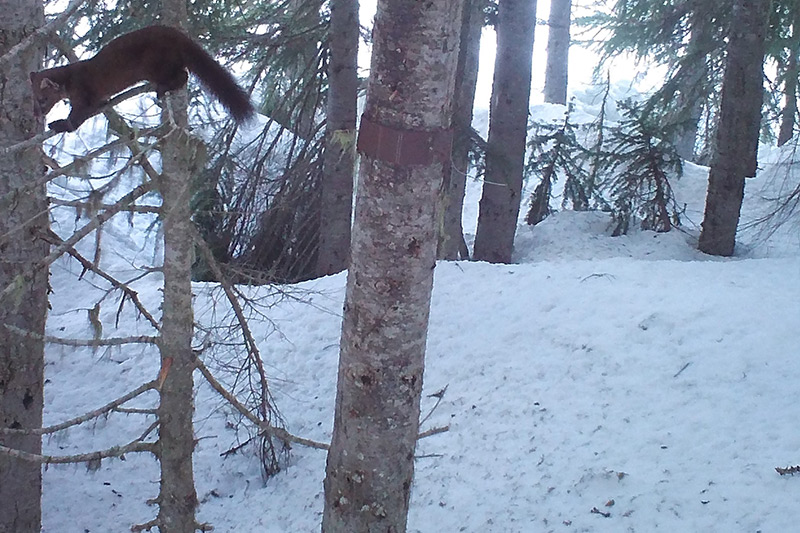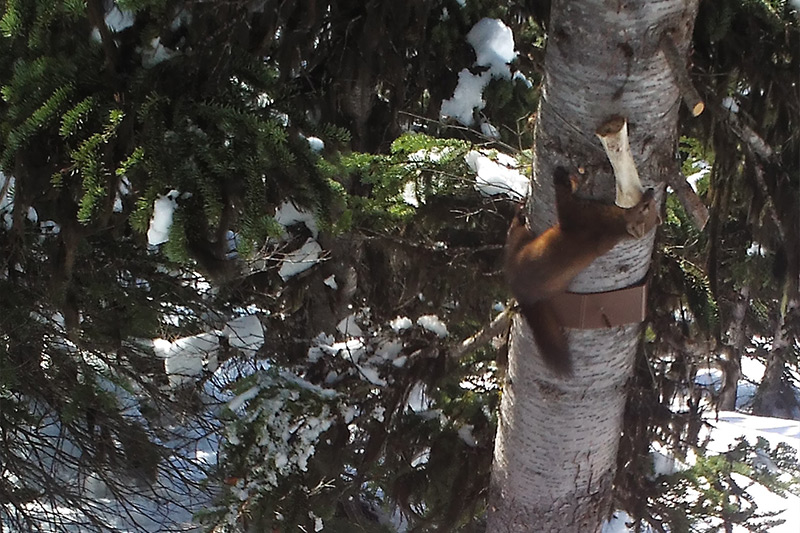OLYMPIC MARTENS
Studying a small Northwest carnivore whose status is a mystery
Studying an elusive species
Pacific martens historically occurred throughout the coniferous forests of the Pacific coastal states in the contiguous U.S., including on Washington’s Olympic Peninsula. By the mid-1900s, martens inhabiting the peninsula were decimated by trapping and reduced to small, isolated sub-populations that likely found refuge at high elevations.
Between 1968–2016, only 9 highly reliable records of Pacific martens were verified on the Olympic Peninsula, and of those only 2 were documented from formal surveys, with the remaining 7 sighted opportunistically by hikers and mountaineers. One of these animals was a young female found dead on a trail in 2008—an unfortunate discovery with a silver lining. Given her young age, we know that at least some martens are still out there reproducing.
Assessing the current Olympic marten distribution and identifying why numbers continue to be small is critical to ensuring the long-term survival of this species and its presence in Pacific Northwest forests. If we don’t know how many are out there, we can’t restore or protect them.
ABOUT THE PROJECT
The Olympic Marten Project represents a partnership between Woodland Park Zoo, Olympic National Forest, Olympic National Park, and the US Forest Service’s Pacific Northwest Research Station. Our goals are to (1) identify small and possibly isolated marten sub-populations, (2) assess the marten’s current distribution, (3) explore possible causes for the population’s apparent lack of recovery, (4) evaluate connectivity among sub-populations, and (5) identify and help advance conservation actions to restore a healthy marten population on the peninsula.
To survey for martens, we are using an innovative tool originally developed by Woodland Park Zoo to monitor wolverines and other rare, high-mobility species in the Washington Cascades. Our high-tech scent dispenser, developed in collaboration with Microsoft, allows us to attract martens to motion-triggered cameras for over a year at remote locations characterized by deep snow in winter—without our having to replenish bait. Our efforts since 2017 have resulted in detections at an 13 locations—a major advance when compared with previous surveys.
Our camera stations also collect information about fishers, a larger cousin to the marten that was exterminated from Washington but reintroduced to the Olympic Peninsula beginning in 2008.
Good News for Martens

Protecting Habitat
Pacific martens remain relatively common in the nearby Cascade Range of Washington. We’re confident that sufficient habitat remains on the Olympic Peninsula to support their recovery.

Community Partnerships
Wildlife agencies, tribal communities, and other local citizens invested in the recovery of fishers on the Olympic Peninsula and made their reintroduction a success. People are curious about martens, too, and public support will play an important role in their conservation.
Woodland Park Zoo is committed to creating partnerships that help protect animals in their natural environment.
WHAT YOU CAN DO
Protect the Forests, Protect the Species
Martens thrive in healthy forests where they can hunt, reproduce, and roam in relatively undisturbed habitat. Pledge to protect Pacific Northwest forests:
Protect Forests
Advocate for protecting forests, and support your community forestry teams such as the Bureau of Land Management and National Forests. Join volunteer groups and clean-up parties to do your part to keep forests healthy.
Consumer Choices
Purchase Forest Stewardship Council-certified paper and wood products to ensure you are being a conscious consumer.
Get Outside
Take a hike. Spending more time in the forest connects us to nature and reminds us to appreciate our Pacific Northwest wild neighbors. Remember to stay on trails, pack out what you pack in, and be good wildlife stewards by keeping pets on-leash and following campfire regulations and other backpacking guidelines.
ABOUT OLYMPIC MARTENS
Native to both the Olympic Peninsula and the Cascade Range, Pacific martens are members of the weasel family and related to fishers and wolverines. Martens are about the size of a gray squirrel, weighing 1–3 pounds, with rounded ears, slender bodies, and long, bushy tails. They prefer well-established forests with a snowpack in winter.
Martens are very athletic and agile; climbing trees or launching themselves across a snow drift is no problem for these surefooted hunters. Their main prey includes hares, mice, squirrels, and other small animals that can be found beneath snow or in thick vegetation. Martens are masters at investigating narrow burrows and fallen trees for their next meal.
In the Cascade Range, martens are often seen on motion-triggered cameras deployed by biologists and citizen scientists. But the Olympic Peninsula presents a different story. Since 1991, numerous camera surveys conducted by the Forest Service and other entities have resulted in hundreds of thousands of photographs, with very few of them containing martens.
The Olympic Peninsula is home to a wide range of carnivores, including black bears, cougars, bobcats, coyotes, fishers, and—at least for now—Pacific martens. The more information we can gather about these elusive animals, the better their chances for recovery in Olympic forests.
MORE WAYS TO HELP